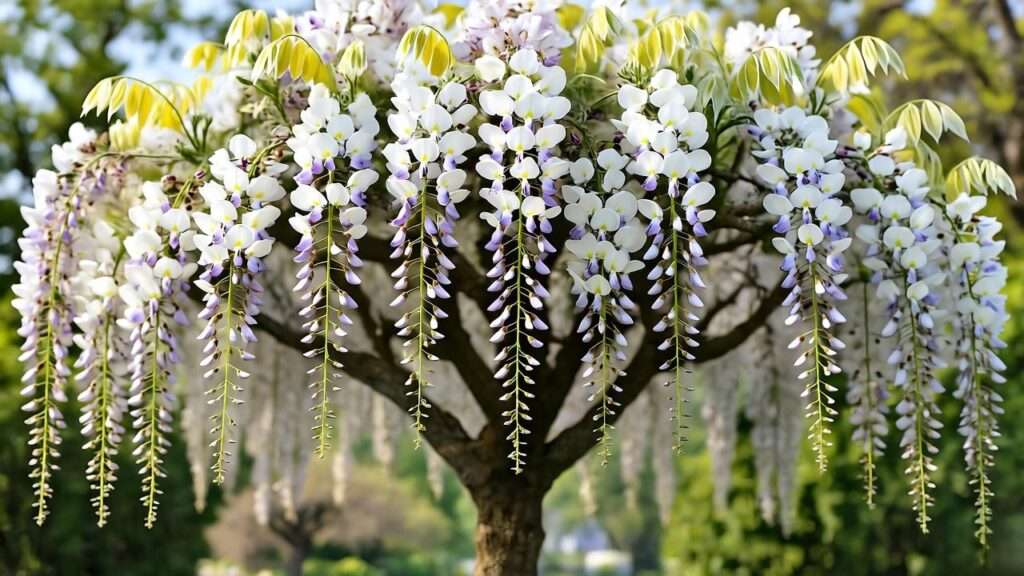Imagine stepping into your garden and being greeted by cascades of fragrant, snow-white blooms draping elegantly from a majestic white wisteria tree. This breathtaking sight isn’t just a dream—it’s achievable with the right knowledge and care. White wisteria trees, known for their romantic charm and lush foliage, are a favorite among gardeners aiming to elevate their outdoor spaces. Whether you’re a seasoned horticulturist or a beginner, this comprehensive guide will walk you through every step of growing and maintaining a thriving white wisteria tree. From planting to pruning, we’ll cover expert tips to ensure vibrant blooms and a healthy tree for years to come. As a horticultural enthusiast with over a decade of experience cultivating ornamental trees, I’ve distilled the best practices to help you avoid common pitfalls and achieve a stunning garden centerpiece. Let’s dive in and transform your garden into a floral paradise! 🌼
1. Understanding the White Wisteria Tree 🌳
1.1 What Is a White Wisteria Tree? 🌼
A white wisteria tree is a cultivated form of wisteria, typically Wisteria sinensis or Wisteria floribunda, trained to grow as a small tree rather than a sprawling vine. Belonging to the Fabaceae family, these deciduous plants are native to East Asia, particularly China and Japan. The white-flowered varieties are prized for their long, drooping clusters of fragrant blooms that appear in late spring to early summer. Unlike their vining counterparts, white wisteria trees are staked and pruned to maintain a single trunk, creating a compact, tree-like structure perfect for gardens or patios.
The white wisteria tree’s blooms, known as racemes, can reach up to 12 inches long, exuding a sweet fragrance that attracts pollinators like bees and butterflies. Its lush green foliage provides shade, while its sturdy trunk adds structural beauty. Understanding its botanical traits is key to providing the right care for this ornamental gem.
1.2 Why Choose a White Wisteria Tree? ✨
White wisteria trees are a gardener’s delight for several reasons. Aesthetically, their cascading white blooms create a romantic, almost ethereal ambiance, making them ideal for focal points in gardens or near seating areas. Practically, they offer shade, attract pollinators, and have a long lifespan—often thriving for decades with proper care. Their versatility suits various garden styles, from cottage to modern minimalist.
Emotionally, a white wisteria tree can transform your outdoor space into a serene retreat, perfect for relaxing or hosting gatherings. Its compact size (typically 10-20 feet tall when trained) makes it suitable for smaller yards, unlike the sprawling vines that require extensive trellises. For gardeners seeking elegance without overwhelming maintenance, this tree is a top choice.
1.3 Common Varieties of White Wisteria 🌸
Several white wisteria cultivars stand out for their beauty and adaptability. Here are three popular options:
- Wisteria sinensis ‘Alba’: Known for its abundant, fragrant white flowers and vigorous growth. Ideal for warmer climates (USDA Zones 5-9).
- Wisteria floribunda ‘Shiro Noda’: Features long, drooping racemes (up to 24 inches) and a slightly slower growth rate, perfect for smaller gardens.
- Wisteria floribunda ‘Longissima Alba’: Offers extra-long flower clusters and excellent cold hardiness, thriving in Zones 4-9.
Expert Tip: Choose a cultivar based on your climate and garden size. For colder regions, ‘Longissima Alba’ is a hardy option, while ‘Alba’ suits warmer areas with ample sunlight.
2. Planting Your White Wisteria Tree 🌱
2.1 Choosing the Right Location 📍
The success of your white wisteria tree begins with selecting the perfect spot. These trees thrive in full sun, requiring at least six hours of direct sunlight daily to produce abundant blooms. A south-facing location is ideal, as it maximizes light exposure. Ensure the site has well-drained soil, as wisteria roots are prone to rot in waterlogged conditions.
Space is another critical factor. While trained as a tree, wisteria can spread 10-15 feet wide at maturity, so avoid planting near walls or other structures where roots could cause damage. Protect the tree from strong winds by choosing a sheltered spot, such as near a fence or building.
Common Mistake: Planting in heavy shade or clay-heavy soil often leads to poor blooming or weak growth. Always check your site’s conditions before planting.
2.2 Preparing the Soil 🧑🌾
White wisteria trees prefer slightly acidic to neutral soil (pH 6.0-7.0) rich in organic matter. Start by testing your soil’s pH using a home testing kit (available at garden centers or online). If the pH is too high, amend with sulfur; if too low, add lime. Incorporate compost or well-rotted manure to improve soil fertility and drainage.
Step-by-Step Soil Prep:
- Dig a hole twice as wide and as deep as the root ball.
- Mix native soil with 30% compost or organic matter.
- Ensure proper drainage by avoiding areas where water pools after rain.
Expert Insight: For precise results, I recommend the Luster Leaf Rapitest Soil Test Kit, which measures pH and nutrient levels accurately.
2.3 Planting Steps for Success 🌞
The best time to plant a white wisteria tree is in spring or fall, when temperatures are mild, allowing roots to establish before extreme weather. Follow these steps for a healthy start:
- Choose a Healthy Tree: Select a nursery-grown wisteria with a strong, straight trunk and no signs of disease.
- Dig the Hole: Make it 2-3 times wider than the root ball but no deeper to prevent settling.
- Stake for Tree Form: Insert a sturdy stake (6-8 feet tall) into the hole to support the trunk.
- Plant and Backfill: Place the tree in the hole, ensuring the root crown is level with the soil surface. Fill with amended soil, tamping gently.
- Water Thoroughly: Soak the soil to settle roots, then mulch with 2-3 inches of organic material.
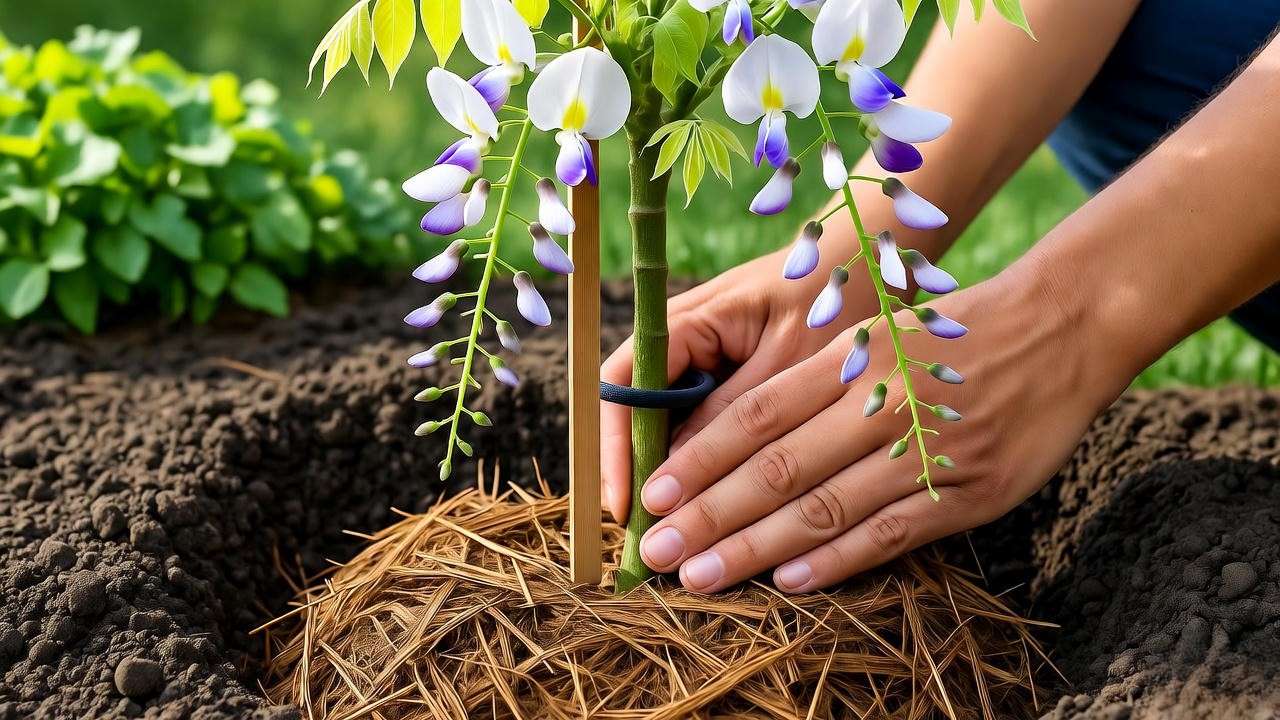
Visual Aid: A diagram showing planting depth and staking would be a great addition to visualize proper technique.
3. Caring for Your White Wisteria Tree 🪴
3.1 Watering Needs 💧
Proper watering is crucial for a healthy white wisteria tree, especially during its first two years. Young trees need deep, infrequent watering—about 1-2 inches per week, depending on rainfall. Use a soaker hose or drip irrigation to deliver water directly to the root zone. Mature trees are more drought-tolerant but still benefit from occasional deep watering during dry spells.
Signs of Watering Issues:
- Overwatering: Yellowing leaves, soggy soil, or root rot.
- Underwatering: Wilting, dry leaves, or stunted growth.
Seasonal Adjustments: Increase watering in summer, especially during heatwaves, and reduce in winter when the tree is dormant.
3.2 Fertilizing for Vibrant Blooms 🌺
To encourage prolific blooms, use a low-nitrogen, high-phosphorus fertilizer, such as a 5-10-10 blend, which promotes flowering over excessive foliage. Apply in early spring before growth begins and again in mid-summer after the first bloom cycle. Spread the fertilizer evenly around the drip line (the area beneath the outermost branches) and water thoroughly.
Expert Tip: Avoid high-nitrogen fertilizers, as they can lead to lush leaves but fewer flowers. A product like Espoma Flower-Tone is a reliable choice for wisteria.
3.3 Pruning and Training ✂️
Pruning is the cornerstone of white wisteria tree care, ensuring both vibrant blooms and a tidy tree shape. Prune twice annually: in late winter (before spring growth) to shape the tree and in mid-summer to control growth and encourage next year’s buds.
Pruning Guide:
- Late Winter: Remove dead or crossing branches, and cut back last season’s growth to 2-3 buds per stem.
- Mid-Summer: Trim new shoots to 6-8 inches to promote flower bud formation.
- Training: Tie the main trunk to the stake, removing lower side shoots to maintain a single trunk.
Common Mistake: Over-pruning in spring can reduce blooms, so focus heavy cuts in winter.
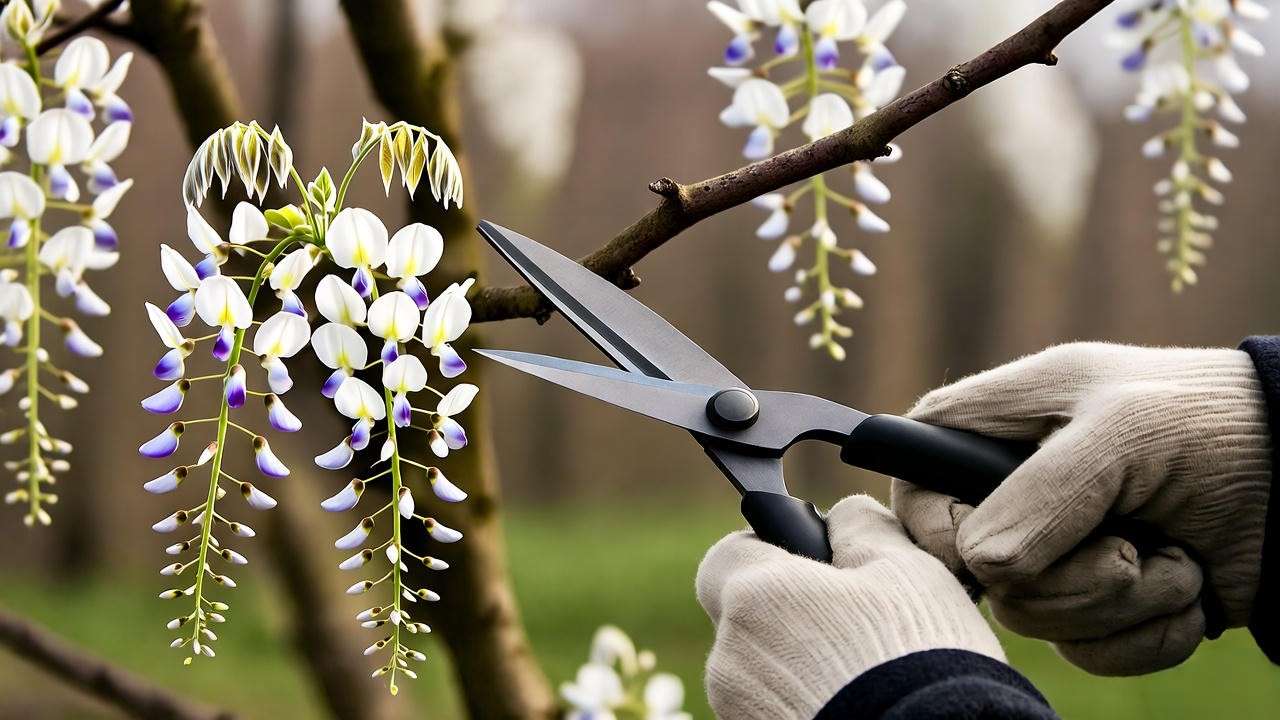
3.4 Mulching and Weed Control 🌾
Mulching conserves moisture, regulates soil temperature, and suppresses weeds around your white wisteria tree. Apply a 2-3 inch layer of organic mulch (e.g., bark chips or shredded wood) around the base, keeping it 2 inches from the trunk to prevent rot. Replenish mulch annually in spring.
For weed control, hand-pull weeds near the tree to avoid disturbing roots. Alternatively, use a pre-emergent herbicide in early spring to prevent weed growth, but ensure it’s safe for ornamental trees.
4. Encouraging Stunning Blooms 🌼
4.1 Understanding Bloom Cycles 🌸
White wisteria trees typically bloom in late spring to early summer, producing cascading racemes of fragrant white flowers that can last for weeks. The bloom cycle depends on factors like sunlight, pruning, and the tree’s age. Young trees, especially those under three years old, may produce sparse or no blooms as they establish their root systems. Full blooming potential is often reached after 3-5 years with proper care.
To maximize blooms, ensure your tree receives at least six hours of direct sunlight daily, as shade significantly reduces flower production. Regular pruning also stimulates bud formation for the next season. Understanding these cycles helps set realistic expectations and guides your care routine.
Expert Insight: Patience is key with young wisteria trees. I’ve seen many gardeners achieve spectacular blooms by sticking to a consistent care schedule over a few seasons.
4.2 Troubleshooting Poor Blooming 😕
If your white wisteria tree isn’t blooming as expected, several factors could be at play. Here are common issues and solutions:
- Insufficient Sunlight: Move container-grown trees to sunnier spots or trim nearby foliage blocking light. For in-ground trees, consider transplanting (best in fall).
- Improper Pruning: Over-pruning in spring or neglecting summer trims can reduce buds. Follow the pruning schedule outlined in Section 3.3.
- Nutrient Imbalance: Excess nitrogen promotes leaves over flowers. Test your soil and switch to a phosphorus-heavy fertilizer like 5-10-10.
- Young Age: If the tree is under 5 years old, give it time to mature.
Case Study: A client in my local gardening community struggled with a non-blooming wisteria for two years. After testing the soil (revealing high nitrogen levels) and adjusting to a bloom-boosting fertilizer, their tree produced vibrant racemes the following spring. Consulting a local arborist can also pinpoint issues specific to your region.
4.3 Enhancing Flower Longevity 🌟
To extend the life of your white wisteria tree’s blooms, adopt these practices:
- Deadheading: Remove spent flower clusters to encourage a second, lighter bloom in some varieties.
- Consistent Watering: Maintain even soil moisture during bloom season to prevent bud drop.
- Pest Control: Monitor for aphids, which can damage buds. Use neem oil for organic control.
Companion Planting Idea: Pair your wisteria with low-growing perennials like lavender or catmint to enhance garden aesthetics and deter pests naturally. These companions also attract pollinators, boosting your garden’s ecosystem.
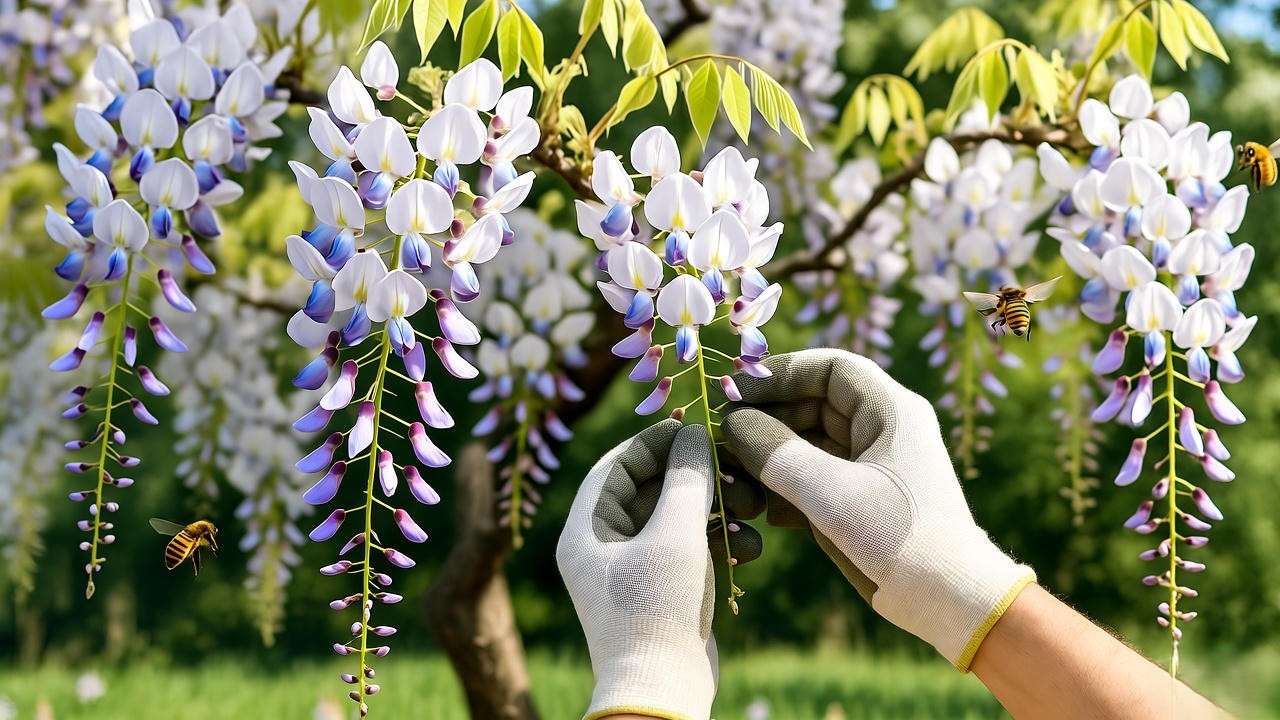
5. Common Problems and Solutions 🐛
5.1 Pests and Diseases 🦟
White wisteria trees are generally hardy but can face pest and disease challenges. Common pests include:
- Aphids: Small sap-sucking insects that cause curled leaves. Treat with insecticidal soap or neem oil.
- Scale Insects: Hard, shell-like pests on stems. Remove manually or use horticultural oil.
- Japanese Beetles: Chew leaves and flowers. Hand-pick or use organic traps.
Diseases to watch for include:
- Root Rot: Caused by overwatering or poor drainage. Ensure well-drained soil and avoid waterlogging.
- Powdery Mildew: White coating on leaves, common in humid conditions. Improve air circulation and apply fungicides if needed.
- Leaf Spot: Dark spots on leaves. Remove affected foliage and avoid overhead watering.
Prevention Tips: Regularly inspect your tree, maintain proper spacing, and clean up fallen debris to reduce disease risk. Organic treatments are often sufficient for minor issues.
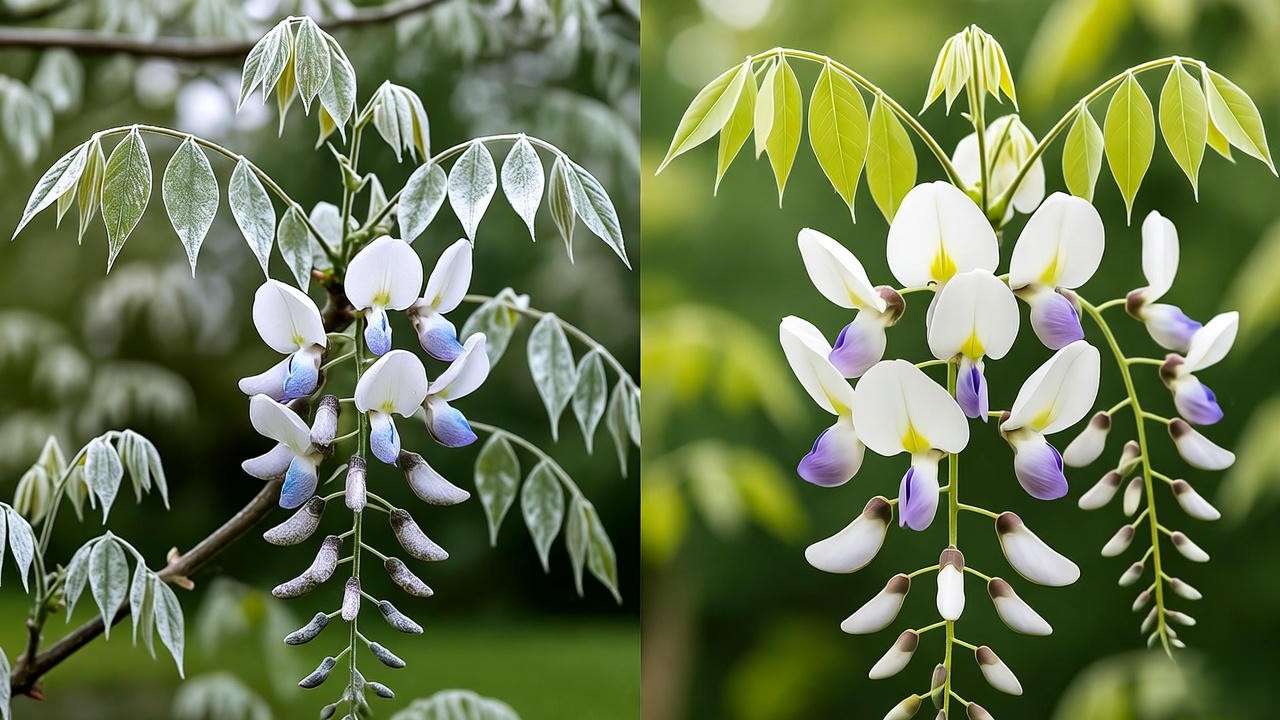
5.2 Environmental Stress 🌪️
Environmental factors can stress your white wisteria tree, leading to symptoms like wilting, yellowing leaves, or stunted growth. Common causes include:
- Drought: Increase watering during dry spells, ensuring deep soaking.
- Poor Soil: Test and amend soil to correct nutrient deficiencies or pH imbalances.
- Extreme Temperatures: Protect young trees from frost with burlap wraps or provide shade during heatwaves.
Solutions: Adjust care based on symptoms. For example, yellowing leaves may indicate overwatering or nutrient deficiency—test soil to confirm. In my experience, consistent monitoring during extreme weather prevents long-term damage.
5.3 Structural Issues for Tree Forms 🪵
When trained as a tree, wisteria may face structural challenges, especially in windy climates. Weak branches or an unstable trunk can lead to breakage. To address this:
- Staking: Use a sturdy, 6-8 foot stake driven deep into the ground. Secure the trunk with flexible ties to allow slight movement, which strengthens the tree.
- Pruning: Regularly remove weak or crossing branches to maintain a balanced canopy.
- Training: Continue shaping the tree by removing lower shoots to preserve the single-trunk form.
Expert Tip: Check ties annually to prevent them from cutting into the bark as the trunk grows. I’ve seen gardeners save struggling trees by reinforcing stakes after stormy seasons.
6. Seasonal Care Calendar 📅
A consistent care routine ensures your white wisteria tree thrives year-round. Here’s a seasonal breakdown:
- Spring 🌱:
- Plant new trees or transplant established ones.
- Apply a high-phosphorus fertilizer to boost blooms.
- Begin light pruning to shape the tree and remove winter damage.
- Summer ☀️:
- Water deeply during dry periods, especially for young trees.
- Monitor for pests like aphids or beetles and treat promptly.
- Trim new shoots to 6-8 inches in mid-summer to encourage bud formation.
- Fall 🍂:
- Replenish mulch to insulate roots for winter.
- Test soil and amend as needed for next season.
- Stop fertilizing to allow the tree to enter dormancy.
- Winter ❄️:
- Perform heavy pruning in late winter to shape the tree and stimulate spring growth.
- Protect young trees from frost with burlap or frost cloth.
- Inspect stakes and ties for stability.
Visual Aid: A downloadable PDF calendar with monthly tasks would help readers stay organized. For example, mark “Prune in February” or “Fertilize in April” for easy reference.
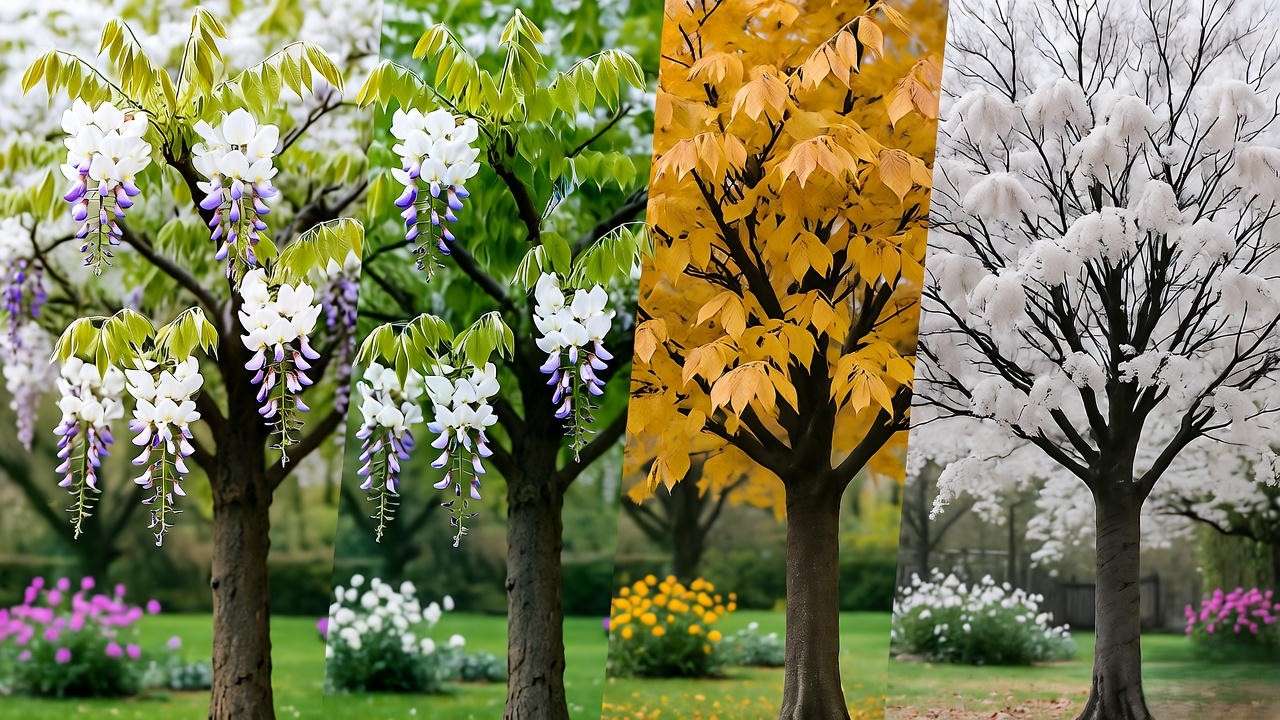
7. Expert Tips for Long-Term Success 🌟
For gardeners aiming to take their white wisteria tree to the next level, consider these advanced techniques:
- Grafting: For stronger trees, graft a white wisteria scion onto a hardy rootstock. This is best done by professionals but can improve vigor.
- Root Pruning: For container-grown trees, prune roots every 2-3 years to control size and encourage healthy growth.
- Sustainability: Use organic fertilizers and collect rainwater for irrigation to reduce environmental impact.
Personal Story: In my early years as a horticulturist, I struggled with a wisteria that refused to bloom. After consulting a master gardener, I learned the importance of summer pruning—a game-changer that led to a spectacular display the next season. This experience taught me the value of timing and precision in wisteria care.
Community Advice: Local gardening forums often share region-specific tips. A master gardener in my area recommends checking soil drainage annually, as compacted soil can hinder wisteria growth.
8. FAQs About White Wisteria Tree Care ❓
- How long does it take for a white wisteria tree to bloom?
Most trees begin blooming 3-5 years after planting, with full blooms possible after 5-7 years. Consistent care accelerates this timeline. - Can white wisteria trees grow in containers?
Yes, but choose a large container (15-20 gallons) with excellent drainage. Regular root pruning and fertilizing are essential. - Are white wisteria trees toxic to pets?
Yes, all parts of wisteria are toxic to dogs, cats, and horses. Keep pets away from fallen seeds or pods. - How do I prevent my wisteria from becoming invasive?
Regular pruning and removing suckers prevent unwanted spread. Avoid planting near structures where roots could cause damage. - What’s the best way to propagate a white wisteria tree?
Softwood cuttings in early summer or grafting are effective. Propagation requires patience, as new plants take years to bloom.
9. Conclusion 🌿
A white wisteria tree is more than just a plant—it’s a living masterpiece that can transform your garden into a fragrant, elegant haven. By following this guide’s expert tips on planting, pruning, fertilizing, and troubleshooting, you’ll be well-equipped to grow a thriving tree with vibrant blooms. From choosing the right location to mastering seasonal care, every step you take brings you closer to a stunning garden centerpiece. Start your wisteria journey today, and don’t be afraid to experiment with pruning or companion planting to make your tree truly unique. Share your progress in the comments, download our seasonal care calendar, or explore our other plant care guides for more inspiration. Here’s to blooming success! 🌸
Call-to-Action: Have a wisteria story or question? Drop it in the comments below, or check out our related articles on flowering trees and garden design for more tips!

